I never knew you; depart from me (Matthew 7:23)
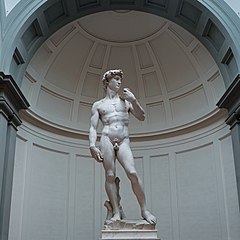
David, Michelangelo, Florence, Galleria dell’Accademia, 1501-1504, Author Jörg Bittner Unna, 21 July 2021, CCA-SA 4.0 license.
Last month, the principal of Tallahassee Classical School (TCS) in Florida reluctantly resigned from her role. Principal Hope Carrasquilla’s resignation was incited by complaints by a small number of parents who resented not having been informed in advance that a lesson plan for sixth-grade students contained “controversial” material. That material? A photograph of Michelangelo’s David.
David is a monumental marble statue depicting the Biblical figure David, the future king of Jerusalem, carrying the sling with which he killed the giant Goliath. At seventeen feet in height, the sculpture is a tour-de-force of both artistry and engineering. Widely admired at its completion in 1504, the David remains world-renowned to this day. In accordance with the classical ideals which shaped Renaissance sculpture, David is portrayed in the nude. This last aspect was the cause of its downfall at the Florida school.
In their complaints, parents expressed shock and dismay that their children had been exposed to the Renaissance masterpiece, which one of them described as “pornographic.” The kindest remark that can be made about the parents who objected to the David as pornographic is that they have evidently never seen any actual pornography.
Cecilie Hollberg, director of the Galleria dell’Accademia in Florence, home to the David, was not so charitable. She decried the ignorance of the parents, and of the school which tacitly endorsed their complaint, saying “To think that David could be pornographic means truly not understanding the contents of the Bible, not understanding Western culture and not understanding Renaissance art.” Hollberg invited the students at the Tallahassee school to Florence, to discover the “purity” of the sculpture in person. The mayor of Florence has also issued an invitation to the former principal of the Tallahassee school to visit the city, calling the protest against David “ridiculous.”[1]
The Tallahassee school appears to have been in a turbulent state for some time – Ms. Carrasquilla, who lasted less than a year as the principal, is the third person to serve in the role since 2020. Hillsdale College, a hyper-conservative institution that promotes the ‘classical’ education model, and which had fundraised for the school in the past, cut ties with TCS after the controversy was reported in the news.
The Florida Department of Education was also quick to distance itself from the school’s decision, declaring “The Statue of David has artistic and historical value. Florida encourages instruction on the classics and classical art, and would not prohibit its use in instruction,” adding that “The matter at Tallahassee Classical School is between the school and an employee, and is not the effect of state rule or law.”[2] Carrasquilla’s firing may have brought an end to the crisis within the school itself, but the discussion of the incident rages on.
And there is no new thing under the sun (Ecclesiastes 1:9)
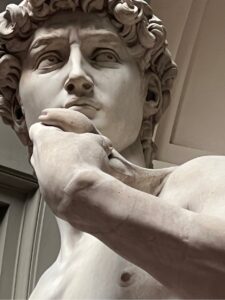
Michelangelo, David, detail, Galleria dell’Accademia, Florence.
The school’s censorship of David has already sparked innumerable news articles and opinion pieces. A Hyperallergic article pointed out the uncanny resemblance of the current controversy to a Simpsons episode from 1990, in which Marge Simpson’s opposition to a violent children’s television show escalates uncontrollably into a mass protest against, yes, Michelangelo’s David. As one of the protesting parents tells a bewildered Marge, “It’s filth … it graphically portrays parts of the human body, which, practical as they may be, are evil.”
The most high-profile reaction to the idea of David’s being flagged as “controversial” was a Saturday Night Live sketch featuring “David” defending himself against charges of indecency. Saturday Night Live’s sketch and the Simpsons episode both speak to the roots of the current controversy over David – the centuries-old debate over whether art is, can be, or should be ‘moral’, and who is qualified to make that judgement.
Shocking as the recent attacks on the arts in this country are, they are also nothing new. In the same year that the Simpsons parodied the censorship of David, the National Endowment for the Arts was embroiled in multiple controversies surrounding this same question of morality in art. One such crisis involved the NEA’s past grants to Andres Serrano and Robert Mapplethorpe, both of whose works were deemed offensive by some audiences. The other involved four performance artists who sued the NEA after their grants were vetoed by a single member of the Endowment’s board, John Frohnmayer. Frohnmayer, who was appointed to the NEA board by President G. H. W. Bush, vetoed the grants after the artists’ work had already passed the peer review process, on the grounds that their subject matter was inappropriate. The artists won their suit, but as a consequence of the ongoing controversies, the NEA ceased to offer grants to individual artists.
The NEA’s troubles in the 1990s, like the resignation of the Florida principal, were not sparked by widespread public outcry. They were triggered by the objections of a small number of people with an extreme reaction to a piece of art, and who managed to make their point of view the rule of law for an entire nation. As Marge Simpson regretfully observed at the close of the Simpsons episode, “I guess one person can make a difference, but most of the time they probably shouldn’t.”
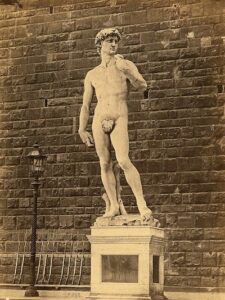
Michelangelo, “David,” 1504, photo before 1973, with a loin-covering added by city officials, photo by John Brampton Philpot, taken outside the Palazzo Vecchio, Department of Image Collections, National Gallery of Art Library, Washington, DC.
Today, the debate over art and morality has once again leapt out of the confines of classrooms, opinion columns, and talk shows, and into national politics. Ron DeSantis, Florida’s governor, has appointed himself the champion of a hyper-conservative movement aiming to suppress certain forms of artistic expression. He would like to curtail drag shows, censor school textbooks and ban other books from libraries, and has restricted teachers from discussing sex orientation and gender identity in elementary through high school classrooms. DeSantis’ campaign has prompted criticism from civil rights groups, brought him into direct conflict with America’s most powerful cultural juggernaut, the Disney company, and drawn mockery from many quarters. But it has also attracted support from conservatives who resent the rise of a liberal, tolerant, mindset in American popular culture. Book bans and attempts to defund public libraries are on the rise across the country, as are laws restricting or outlawing drag performances.
Attacks on cultural expression are never confined to the arts themselves, but inevitably extend to attacks on artists, and their audiences. Acts of censorship are not only infringements on the freedom of speech, but also tacit endorsements of the old idea that authorities are qualified to dictate to others what is, and is not, acceptable to express in in art. An instance of an artist being held to account for the morality of their work took place during the trial following Oscar Wilde’s suit for libel. The trial took a turn for the bizarre when Wilde was held to account, not for his own actions, but for those of the characters in his new novel, The Picture of Dorian Gray. When accused by the opposing lawyer of having written a novel “open to the interpretation of being [perverted],” Wilde answered, “That could only be to brutes and illiterates. The views of Philistines on art are incalculably stupid.” It is a wonderful irony that, in the Bible, the people who sent out Goliath as their champion, only to see him defeated by David – were the Philistines.
Saturday Night Live picked up the debate where Wilde left it. An actor portraying the “David” dismisses his critics as ignorant and uncultured fools, saying “Those parents are ignorant prudes… I’m the world’s greatest sculpture and I’m a very pretty boy.”[3] Satisfying as it may be to scoff at the unsophisticated, we have still to contend with their views, especially when they are held by a state governor and prospective presidential candidate.
To the pure all things are pure (Titus 1:15)
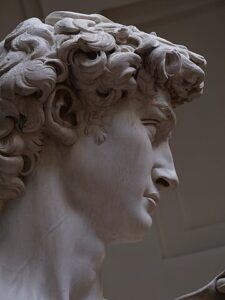
Michelangelo, Florence, Galleria dell’Accademia, 1501-1504, Author Jörg Bittner Unna, 21 July 2021, CCA-SA 4.0 license.
In addition to his other conservative cultural positions, DeSantis is also a strong supporter of the “classical education curriculum.” His notorious Parents’ Rights Bill, called Don’t Say Gay by its opponents, was signed at another “classical” school in Florida, which was, like the Tallahassee Classical School, affiliated with Hillsdale College. The appropriation by Hillsdale College and its affiliated school of the label “classical” for their restricted – and apparently anti-Renaissance – curriculum, is paradoxical. The Tallahassee Classical School’s own website frames its education program as the study of the traditional liberal arts and sciences, which cultivates wisdom and virtue through the pursuit of truth, goodness and beauty.
There is a fundamental conflict between the humanist values the school claims to espouse, and their aversion to the art of the Renaissance – the same transformative cultural period that produced modern humanism. One wonders which of the central pursuits of the school David conflicted with. Was it truth, goodness, or beauty, that the sculpture lacked?
Their curriculum further claims that “teachers will support students as they grapple with difficult arguments through documents and great literary works from a wide variety of cultures and philosophies.” Yet, if their treatment of David as controversial is a precedent, and the will of reactionary parents rules the school, then they will need to exclude vast swathes of Western cultural history from their curriculum. ‘Western civilization’ includes a lot of frank discussion and portrayal of nudity, sex, and violence: The Illiad, Plato’s Symposium, the poems of Catullus and John Donne alike, Sir Thomas Malory’s Le Morte d’Arthur, all seem likely victims of parental censorship in the future. Barring depictions of nudes excludes the study not only of classical works such as the Doryphoros of Polyclitus, but also of many other Renaissance masterpieces, such as Donatello’s David and Titian’s Venus of Urbino, as well as her modern sibling, Manet’s Olympia.
The parents’ objection to David being shown in class is the more bewildering as it runs contrary, not only to the supposed values of the school, which they chose to enroll their children in, but also to the mainstream of American culture, which does not treat David like a dangerous object. Quite the contrary! Replicas of the David are displayed today in many of America’s public parks and museums, including the Ringling Museum of Art in Sarasota, Florida, where a full-size bronze cast of the statue has stood in the museum’s courtyard since 1936.[4] Nude sculptures from many eras and cultures now grace public parks across America, from Augustus Saint-Gauden’s Diana in New Orleans to Rodin’s The Thinker, in Kansas City, Missouri. The original David stood for nearly four hundred years in a central square in Florence, Italy, until 1873, when conservation concerns prompted its replacement with a full-size replica, and the original statue’s removal to the Galleria dell’Accademia.
To see Michelangelo’s David as a controversial subject for a middle-school class discussion requires a degree of retrograde reasoning that even Victorians would have found bizarrely close-minded. As Marla Stone, Andrew W. Mellon Humanities Professor at the American Academy in Rome, told the Associated Press, “What we have here is a moral crusade against the body, sexuality, and gender expression and an ignorance of history. The incident is about fear, fear of beauty, of difference, and of the possibilities embedded in art.”[5]
And the Philistine cursed David by his gods. (1 Samuel 17:43)
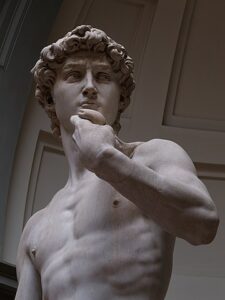
Michelangelo, Florence, Galleria dell’Accademia, 1501-1504, Author Jörg Bittner Unna, 21 July 2021, CCA-SA 4.0 license.
In a better school, where great art could be shown without restraint, what might students learn from the study of Michelangelo’s David? A studio art class might employ the statue as a subject for drawing practice, or a model for the study of proportions and anatomy. A history class could use David as a focus for learning about the Italian city-states, the Catholic Church, and mediaeval craft guilds, all of which played a role in the statue’s commissioning. An art history class, above all, might spend a day studying David, learning about the Renaissance’s fusion of classical and medieval culture, about the high value placed on Carrara marble as a medium, and, perhaps, by reading Giorgio Vasari’s account of the statue’s creation in The Lives of the Most Excellent Painters, Sculptors, and Architects, a sixteenth-century biographical work and the foundational text of modern art history.
Vasari frames the sculpture as a symbol of the power of art to uncover beauty in seemingly worthless material. He records how Michelangelo carved David from a vast piece of marble that had already been cut into, and indeed damaged, by another artist, some years before, so that “it was granted to him as a thing of no value, they thinking that whatever he might make of it would be better than the state in which it was at that time.” Michelangelo triumphed over the challenge of working around his predecessors’ mistakes, so that the valuable marble was not wasted, but instead transformed into an unprecedented masterpiece – the first colossal marble statue created since the fall of the Roman Empire. Vasari marvels at the skill and insight that brought David into being, for “truly it was a miracle on the part of Michelagnolo to restore to life a thing that was dead.”
The finished statue was considered as a possible ornament for the Florence cathedral, but its massive size made it impossible for the church’s engineers to lift it up to its intended place on the roof. Instead, after much debate, the statue was erected in the square directly in front of the Palazzo della Signoria, the main governmental building in the city. Vasari claims that Michelangelo had always intended that the sculpture should stand there, “fashioning … it, as a device for the Palace, a young David with a sling in his hand, to the end that, even as he had defended his people and governed them with justice, so those governing that city might defend her valiantly and govern her justly.”
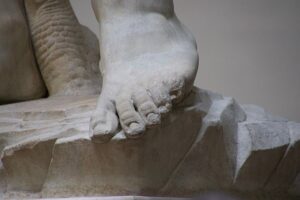
Damage to David’s left foot caused by attack by a man with a hammer, Photo Mjlachance1, 19 September 2017.
Vasari’s description of Michelangelo’s David as a model of justice and courage in government brings to mind one other text that might be relevant in an interpretation of Michelangelo’s David – the Bible. The story of David appears in the Book of Samuel. Israel was invaded by a group of people called the Philistines, who sent out the giant Goliath as their champion, and demanded that the Israelites provide a champion of their own to challenge him, with the rule of Israel going to the victor. Only David, a young shepherd boy, was brave enough to face Goliath, killing him with a stone from his sling. Michelangelo’s David portrays him with the sling still slung over one shoulder, ready for battle. There is even a Biblical justification for his nudity, as David is offered a sword and armor by Saul, but refuses them, because he is not experienced at fighting fully armed. David’s courage and faith, not physical strength or superior weaponry, enabled him to save the people of Israel from the invading Philistines.
Since the nineteenth century, “Philistine” has come into use as a term for the ignorant, the narrow-minded, the reactionary, and the prudish among us, those who seek to repress, censor, or destroy art because they cannot be troubled to understand it. At this moment, the Philistines are once again at the gates, waiting to see if they will be challenged, or if the American people will let them have the final say over what kinds of art can be made, or shown, or taught. This may be the moment for the true lovers of culture and history, to say, with Oscar Wilde, that “the views of Philistines on art are incalculably stupid,” and to stand up, like the young David, and refuse to let Philistines run our country or our schools.
[1] https://apnews.com/article/italy-michelangelo-hillsdale-florida-florence-david-56d2977c3fceefd02f475f9d4d0be3d9
[2] https://flvoicenews.com/florida-education-department-encourages-instruction-on-classical-art-and-david-sculpture/?web=1&wdLOR=c95063967-D3D6-754F-B9DC-8E396A56EB5D
[3] https://www.theartnewspaper.com/2023/04/03/im-proud-of-my-tiny-shiny-penismichelangelos-cancelled-david-bares-all-on-saturday-night-live
[4] https://emuseum.ringling.org/objects/26885/david?ctx=8d1805303dfbe1d6d0f4d7ee674f84120490b21a&idx=19
[5] https://apnews.com/article/italy-michelangelo-hillsdale-florida-florence-david-56d2977c3fceefd02f475f9d4d0be3d9
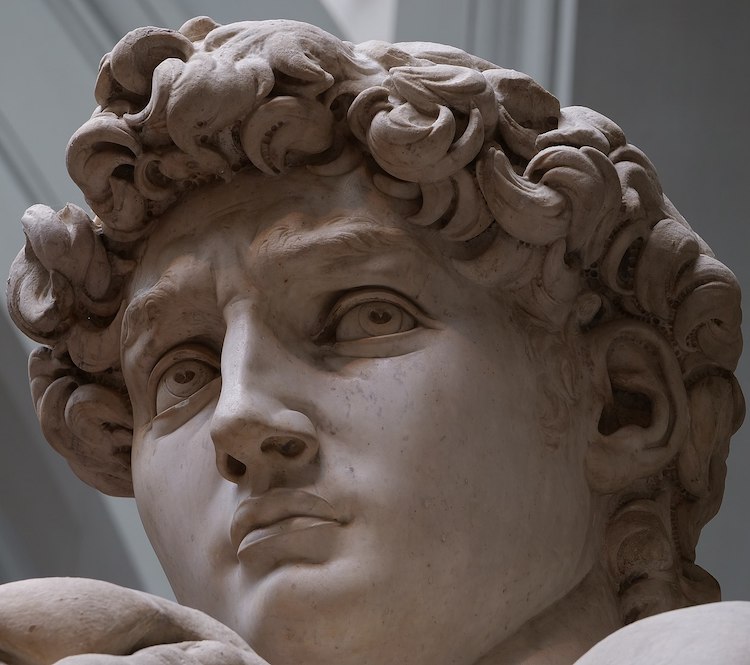 David by Michelangelo, Florence, Galleria dell'Accademia, 1501-1504, Author Jörg Bittner Unna, 21 July 2021, CCA-SA 4.0 license.
David by Michelangelo, Florence, Galleria dell'Accademia, 1501-1504, Author Jörg Bittner Unna, 21 July 2021, CCA-SA 4.0 license. 

